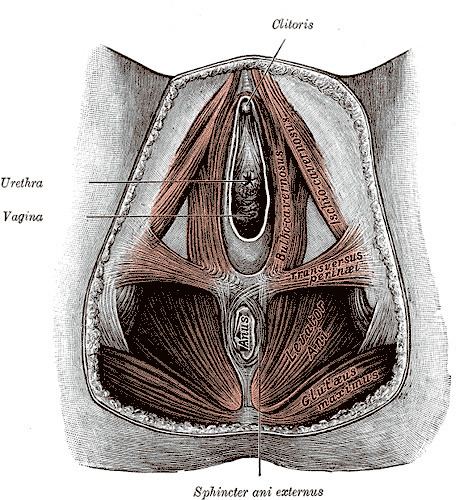TA A09.5.00.001 | Latin Perineum, perinaeum | |
 | ||
Nerve Lymph Primarily superficial inguinal lymph nodes | ||
In human anatomy, the perineum (/pɛrᵻˈniːəm/; Late Latin, from Greek περίνεος – perineos) is the region of the body between the pubic symphysis (pubic arch) and the coccyx (tail bone), including the perineal /pɛrəˈniːəl/ body and surrounding structures. There is some variability in how the boundaries are defined. The perianal area (peri- + anal) is a subset of the perineal area.
Contents
The perineum is an erogenous zone for both males and females. Perineal tears and episiotomy often occur in childbirth with first-time deliveries, but the risk of these injuries can be reduced by preparing the perineum, often through massage.
Structure
The perineum is generally defined as the surface region in both males and females between the pubic symphysis and the coccyx. The perineum is below the pelvic diaphragm and between the legs. It is a diamond-shaped area that includes the anus and, in females, the vagina. Its definition varies: it can refer to only the superficial structures in this region, or it can be used to include both superficial and deep structures. The perineum corresponds to the outlet of the pelvis.
A line drawn across the surface connecting the ischial tuberosities divides the space into two triangles:
The formal anatomical boundaries of the perineum may be said to be:
Body
The perineal body (or central tendon of perineum) is a pyramidal fibromuscular mass in the middle line of the perineum at the junction between the urogenital triangle and the anal triangle. It is found in both males and females. In males, it is found between the bulb of penis and the anus; in females, is found between the vagina and anus, and about 1.25 cm in front of the latter.
The perineal body is essential for the integrity of the pelvic floor, particularly in females. Its rupture during vaginal birth leads to widening of the gap between the anterior free borders of levator ani muscle of both sides, thus predisposing the woman to prolapse of the uterus, rectum, or even the urinary bladder.
At this point, the following muscles converge and are attached: 1. External anal sphincter 2. Bulbospongiosus muscle 3. Superficial transverse perineal muscle 4. Anterior fibers of the levator ani 5. Fibers from male or female external urinary sphincter 6. Deep transverse perineal muscle
Fascia
The terminology of the perineal fascia can be confusing, and there is some controversy over the nomenclature. This stems from the fact that there are two parts to the fascia, the superficial and deep parts, and each of these can be subdivided into superficial and deep parts.
The layers and contents are as follows, from superficial to deep:
Areas of the perineum
The region of the perineum can be considered a distinct area from pelvic cavity, with the two regions separated by the pelvic diaphragm. The following areas are thus classified as parts of the perineal region:
Clinical significance
Extensive deformations of the pelvic floor structures occur in the course of a vaginal delivery. Approximately 85% of women suffer some extent of perineal trauma during a vaginal delivery and in about 69% suturing is required. Obstetric perineal trauma is a distressing event significantly contributing to postpartum morbidity and frustration of women after delivery. In many women the childbirth trauma is manifested in advanced age when the compensatory mechanisms of the pelvic floor become weakened making the problem more serious among the aged population.
The anogenital distance is a measure of the distance between the anus and the base of the penis or vagina. Studies show that the human perineum is twice as long in males as in females. Measuring the anogenital distance in neonatal humans has been suggested as a noninvasive method to determine male feminisation and thereby predict neonatal and adult reproductive disorders.
Society and culture
There are a number of American slang terms commonly used for this area of the human body, such as "taint", "choad", "grundle", and "bonch".
